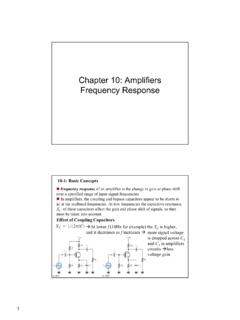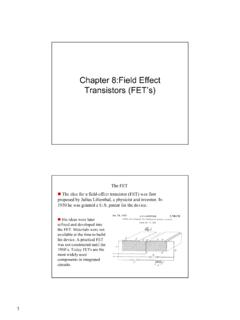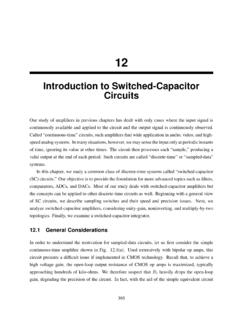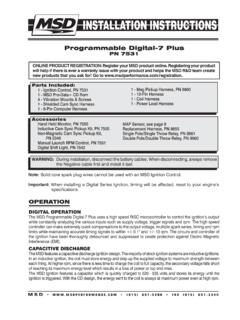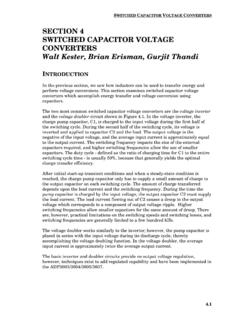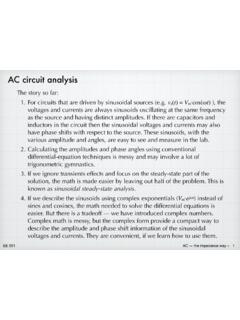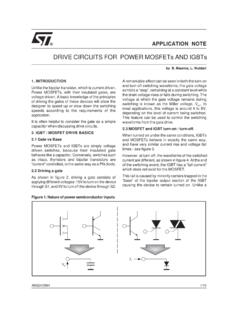Transcription of Chapter 9: FET Amplifiers And Switching Circuits
1 1 Chapter 9: FET Amplifiers And Switching Circuits9-1: The Common Source Amplifier (CS Amplifier)FET has an important advantage compared to the BJT due to the FET sextremely high input impedance. Disadvantages, however, include higher distortion and lower gain. The common-source (CS) amplifier iscomparable to the common-emitter BJT amplifier that you studied in Chapter AC Model: the ac model for FET is shown belowresistance source-to-drain internal theissource anddrain between appear current theis g resistance internal source gate theis 'm'dsgsgsrVrSince is very large and is also large they can be neglected Simplified model29-1: The Common Source AmplifierFET AC ModelAn ideal ac circuit model with ac drain resistance Rdcan be represented as shown.
2 The voltage gain for the circuit shown isgsdsinoutvVVVVA==butandFrom definition of transconductanceEx: for a JFET with gm= 4mS and Rd= ideal voltage gain is Av= gmRd= (4mS)( ) = 69-1: The Common Source AmplifierJFET Amplifier OperationIn common source self biased amplifier, Vinis applied to the gate and Voutis taken from the drain as shown with phase difference between them 180 Remember that, for ac signal, capacitors are short and VDDis ac ground source terminal Sand RDare connected to the round in ac equivalent circuit39-1: The Common Source AmplifierJFET Amplifier Operation: A Graphical Picturethe operation of n-channel JFET shown above with Vinand Vouton IDcharacteristic curve and on transfer characteristic curve is shown belowAs Vgsvaries Id varies; As Vgsdecrease (more negative) from Q-point Iddecreases and As Vgsincrease Idincreases.
3 The corresponding change in Vdsshow the inverse (because VD= VDD-IDRD).9-1: The Common Source AmplifierJFET Amplifier Operation: DC AnalysisFrom the DC equivalent circuit of the amplifier, the Q-point can be found graphically as described before in Chapter 8 for the self biased transistor Once finding IDyou can find VD49-1: The Common Source AmplifierJFET Amplifier Operation: DC Analysis: ExampleDraw the load line from the two points first point (ID=0 and VGS= 0 ) and the second point ID= IDSSand VGS= -IDRS From graph at Q-point, ID= mA and VGS= V9-1: The Common Source AmplifierJFET Amplifier Operation: AC AnalysisThe ac equivalent circuit can be drawn The amplifier circuitAc equivalent circuitAc equivalent circuit showing Vinand VoutInput resistanceVery smallOutput resistanceRout= Rdwith no RL Rd= RDWith load RL Rd= RD//RLVoltage gaindmgsdsinoutvRgVVVVA===59-1: The Common Source AmplifierJFET Amplifier Operation: AC Analysis - ExampleVoltage gain with load < voltage gain without load9-1: The Common Source AmplifierJFET Amplifier Operation: AC Analysis - Example Rin RG69-1: The Common Source AmplifierD-MOSFET Amplifier Operation: A zero-biased common-source amplifier for n-channel D-MOSFET is shown.
4 VGS= 0 The signal voltage causes Vgsto swing above and below its zero value, producing a swing in Idabove and below Q-point, as shown on characteristic transfer curve When Vgs< 0 the depletion mode, and Iddecreases. When Vgs> 0 the enhancement mode, and Id increasesAt VGS= 0 ID= IDSS VD= VDScan be calculatedThe ac analysis is the same as for the JFET : The Common Source AmplifierE-MOSFET Amplifier Operation: A voltage divider common-source amplifier for n-channel E-MOSFET is shown. The gate is biased with a positivevoltage such that VGS> VGS(th) Dc analysis Ac analysiswhere Voltage gain is same as for JFET dmgsdsinoutvRgVVVVA===79-1: The Common Source AmplifierE-MOSFET Amplifier Operation: Example9-2: The Common Drain Amplifier (CD Amplifier) or source follower In a CD amplifier, the input signal is applied to the gate and the output signal is taken from the source.
5 There is no drain resistor, because it is commonto the input and output signals. Ac equivalent circuitsgsmgssgsmsdgssdsgssinoutvRVgVRVg RIVRIVVVVVA+=+=+== The voltage gain isInput Resistancewhere89-2: The Common Drain AmplifierExampleDetermine the voltage gain and the input resistance of the amplifier in Figure 9 20. VDDis negative because it is a p-channel device. From data sheet gm= yfs= 1000 S, IGSS= 5 nA (maximum) at VGS= 20 : The Common Gate Amplifier (CG Amplifier) In a CG amplifier, the input signal is applied to the source and the output signal is taken from the The voltage gain isInput Resistance99-3: The Common Gate Amplifier (CG Amplifier)Example9-3: The Common Gate Amplifier (CG Amplifier)The Cascode Amplifier A cascodeamplifier is one in which a common-source amplifier and a common-gate amplifier are connected in a series arrangement as shown below.
6 As noted from figure, the input resistance (1/gm) for CG amplifier represent the drain resistance Rdfor CS amplifier The cascode amplifier using JFET sprovides a very high input resistance and significantly reduces capacitive effects to allow for operation at much higher frequencies, used for RF (radio frequency), than a common-source amplifier aloneThe voltage gainWhere XLis the reactance of the inductor L shownwith gm(CS) gm(CG)109-5: MOSFET Analogue SwitchingMOSFETs are widely used in analog and digital Switching applications. Generally, they exhibit very low on-resistance, very high off-resistance, and fast Switching Switching Operation E-MOSFETs are generally used for Switching applications: When VGS< VGS(th) MOSFET is off very high RDS When VGS> VGS(th) MOSFET is on very low RDS (VGSmust be sufficiently higher than VGS(th)to be in the upper end of load line in the Ohmic region)9-5: MOSFET Analogue SwitchingMOSFET Switching Operation n-channel E-MOSFET operation as a switchVGSis +V switch onVGSis 0 switch off p-channel E-MOSFET operation as a switchVGSis 0 switch onVGSis +V switch off119-5: MOSFET Analogue SwitchingThe analogue switch A basic n-channel MOSFET analog switch is shown in the figure.
7 The signal at the drain is connected to the source when the MOSFET is turned on by a positive VGSand is disconnected when VGSis 0, as indicated. Variable voltage at the source cause variation in VGS VGSmust be VGS(th)to keep MOSFET maintain conduction (on). Minimum VGSvoltage occurs at ve peak voltage of the output (Vp(out)) 9-5: MOSFET Analogue SwitchingThe analogue switch: Example129-5: MOSFET Analogue SwitchingThe analogue switch: some applications Sampling circuit : analogue to digital conversion Analogue multiplexer: two or more signals are to berouted to the same output switched -Capacitor circuit : where switch MOSFETs with a capacitor can be used to replace a resistor9-5: MOSFET Digital SwitchingMOSFETs are also used in Switching applications in digital integrated circuitsCMOS (Complementary MOS)CMOS combines n-channel and/or p-channel E-MOSFETs in a series arrangement.
8 The shown figure represent a logic Inverter Gatea)Vincan be 0 or 1 (+VDD) Voutis the inverseCMOS inverter operation0110 VoutVinb)Vin= 0 Q1on and Q2off Vout= +VDDc)Vin= +VDD Q1off and Q2on Vout= 0139-5: MOSFET Digital SwitchingCMOS (Complementary MOS): NANDGate and NORGate NAND Gate: When VAAND VBare high, the output is low; otherwise, the output is high. NOR Gate: When VAOR VBOR both are high, the output is low; otherwise, the output is high.

